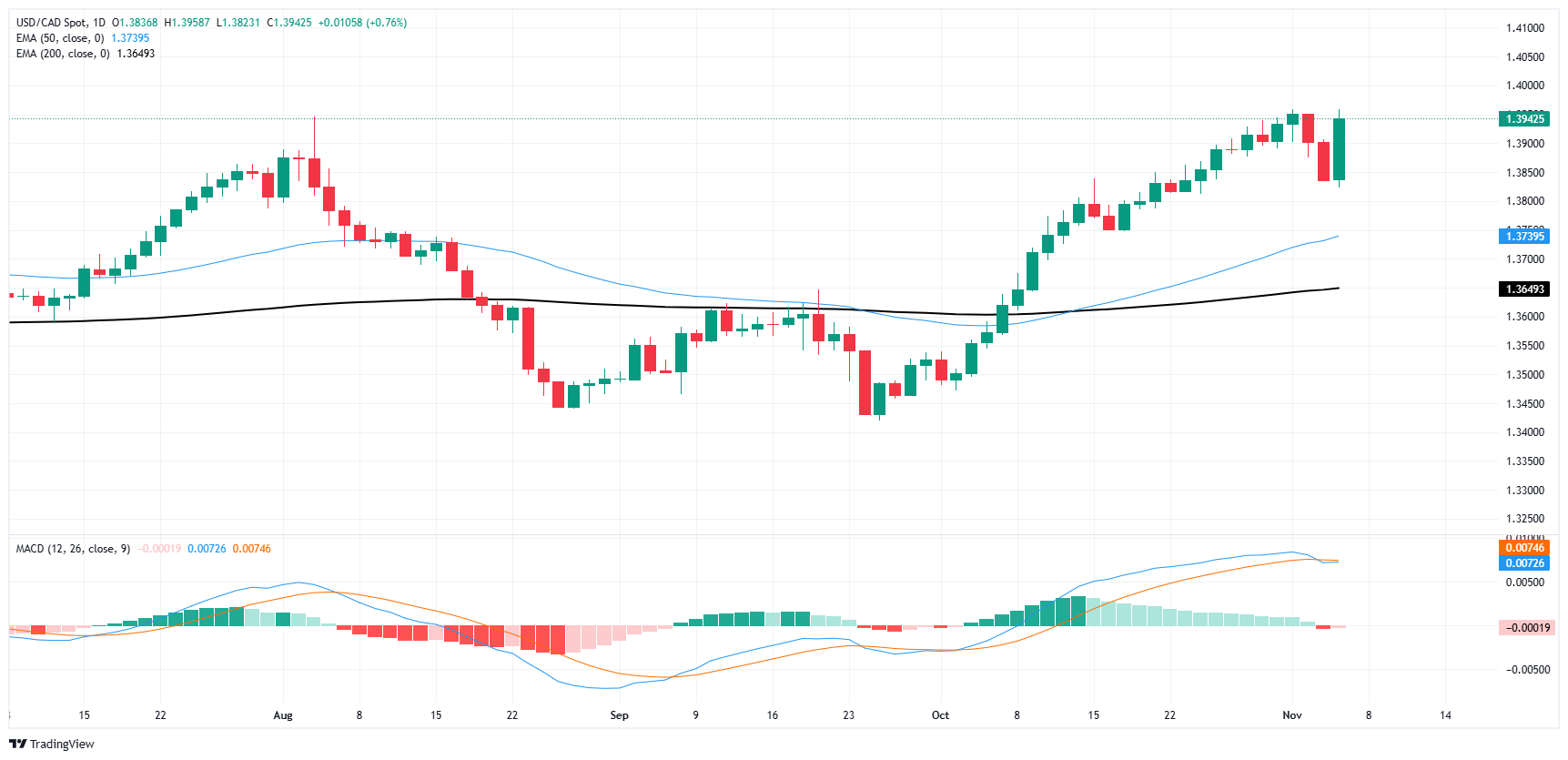Canadian Dollar retests familiar lows as markets pile into post-election push
- The Canadian Dollar shed ground as markets pile back into the US Dollar.
- Canada saw a disappointing print in Ivey PMI figures.
- Investors will now pivot to Thursday’s Fed rate call.
The Canadian Dollar (CAD) snapped a recovery against the Greenback on Wednesday, slipping back into familiar multi-year low territory after markets piled back into the USD following the US presidential election, where presidential candidate Donald Trump is the clear frontrunner. With the US election behind markets, investors are now turning on their heels to face the Federal Reserve’s (Fed) upcoming rate call on Thursday.
Canada saw another dip in its Ivey Purchasing Manager Index (PMI) activity survey results, underpinning the Bank of Canada’s (BoC) ongoing grapple with a lopsided economic landscape. Despite a series of increasing rate cuts from the Canadian central bank, growth and business activity expectations continue to sink.
Daily digest market movers
- The US is set to elect Donald Trump to a second term as President, sparking a broad risk-appetite rally throughout global markets but sending markets piling into the Greenback as well.
- The Fed is widely expected to trim interest rates by a further 25 bps on Thursday.
- Canada saw its seasonally-adjusted Ivey PMI sink to 52.0 in October, down from the previous 53.1 and missing the expected uptick to 54.2.
- A recovery in Canadian PMI figures has stalled out as economic activity figures continue to soften.
- Canadian labor figures are slated for Friday, with Net Change in Employment in October expected to ease lower to 25K from the previous 46.7K.
Canadian Dollar price forecast
The Canadian Dollar (CAD) is back to grappling with lows against the Greenback initially set in late 2022, sending the USD/CAD pair back into the 1.3950 region. A near-term recovery for the Loonie is set to end once again, with USD/CAD on pace to find green territory for a sixth consecutive week.
Despite a flubbed recovery for the Loonie, USD/CAD is knocking against the ceiling of a long-run technical congestion zone. Short pressure may be collecting just below the 1.4000 handle and could keep the pair hobbled and set for a return to the downside.
USD/CAD daily chart
Canadian Dollar FAQs
The key factors driving the Canadian Dollar (CAD) are the level of interest rates set by the Bank of Canada (BoC), the price of Oil, Canada’s largest export, the health of its economy, inflation and the Trade Balance, which is the difference between the value of Canada’s exports versus its imports. Other factors include market sentiment – whether investors are taking on more risky assets (risk-on) or seeking safe-havens (risk-off) – with risk-on being CAD-positive. As its largest trading partner, the health of the US economy is also a key factor influencing the Canadian Dollar.
The Bank of Canada (BoC) has a significant influence on the Canadian Dollar by setting the level of interest rates that banks can lend to one another. This influences the level of interest rates for everyone. The main goal of the BoC is to maintain inflation at 1-3% by adjusting interest rates up or down. Relatively higher interest rates tend to be positive for the CAD. The Bank of Canada can also use quantitative easing and tightening to influence credit conditions, with the former CAD-negative and the latter CAD-positive.
The price of Oil is a key factor impacting the value of the Canadian Dollar. Petroleum is Canada’s biggest export, so Oil price tends to have an immediate impact on the CAD value. Generally, if Oil price rises CAD also goes up, as aggregate demand for the currency increases. The opposite is the case if the price of Oil falls. Higher Oil prices also tend to result in a greater likelihood of a positive Trade Balance, which is also supportive of the CAD.
While inflation had always traditionally been thought of as a negative factor for a currency since it lowers the value of money, the opposite has actually been the case in modern times with the relaxation of cross-border capital controls. Higher inflation tends to lead central banks to put up interest rates which attracts more capital inflows from global investors seeking a lucrative place to keep their money. This increases demand for the local currency, which in Canada’s case is the Canadian Dollar.
Macroeconomic data releases gauge the health of the economy and can have an impact on the Canadian Dollar. Indicators such as GDP, Manufacturing and Services PMIs, employment, and consumer sentiment surveys can all influence the direction of the CAD. A strong economy is good for the Canadian Dollar. Not only does it attract more foreign investment but it may encourage the Bank of Canada to put up interest rates, leading to a stronger currency. If economic data is weak, however, the CAD is likely to fall.
